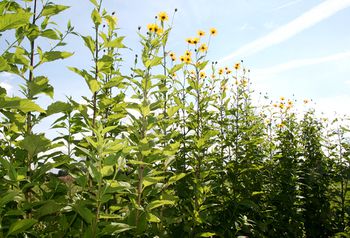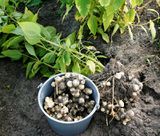Jerusalem artichoke
Jerusalem artichoke or topinambour is a species of sunflower that produces big plants, many relatively small flowers and a rich harvest of tubers. The yield of tubers can come close to that of potato plants. The tubers can be eaten similar to potatoes, but are tastier steamed than boiled. They have a similar consistency, but a sweeter, nuttier flavor; raw and sliced thinly, they can be eaten in a salad.
The green foliage of the plants is an excellent animal feed (my goats and rabbit are very fond of the plants), as are the tubers.
The plant is hardy and can become a pest in your garden if you don't dig out the tubers each year. It can overtake big parts of your garden if left untamed.
Harvesting
For eating them it's best to harvest in late autumn or even throughout the winter. They grow best in autumn. They are hardy and won't spoil when it freezes, only when the soil is frozen you cannot take them out. You can harvest according to your needs. If you wish to harvest them in times that the soil is frozen, you can cover the soil with a layer of straw.
For re-planting the tubers it's best to harvest them in spring.
Garden Journal
- See also Garden Journal for a list with all plants with a garden journal section.
October 2, 2012 - Today i began harvesting Jerusalem artichoke. The harvest is good, as it mostly is for this crop. You can eat the tubers as potatoes or raw.
Jerusalem artichoke is recommended for people suffering from diabetes. When eaten frequently it reduces the blood sugar level. It creates a natural insulin effect in the body. It is high in inulin which only breaks down to fructose in the colon and barely affects blood sugar levels.
Jerusalem artichoke is hardy against frost and can also be harvested in spring, but the voles in my garden tend to be very active through winter so i harvest them now and keep them in boxes with sand in a cellar.
Gallery
See also
External links
- Jerusalem artichoke Wikipedia



